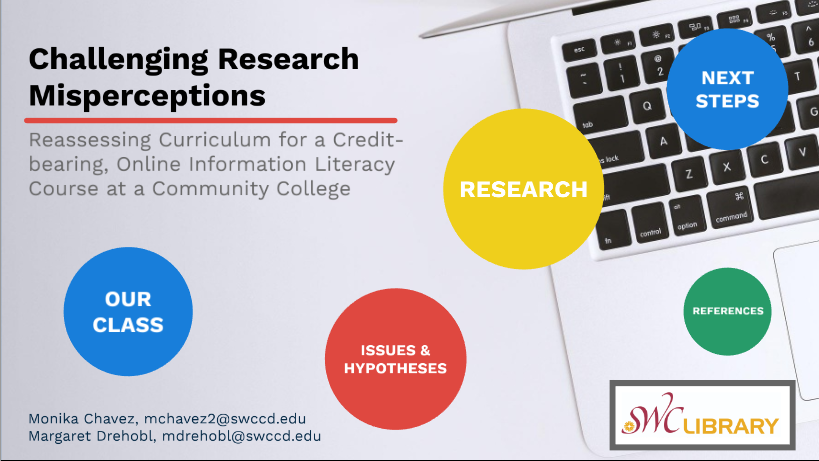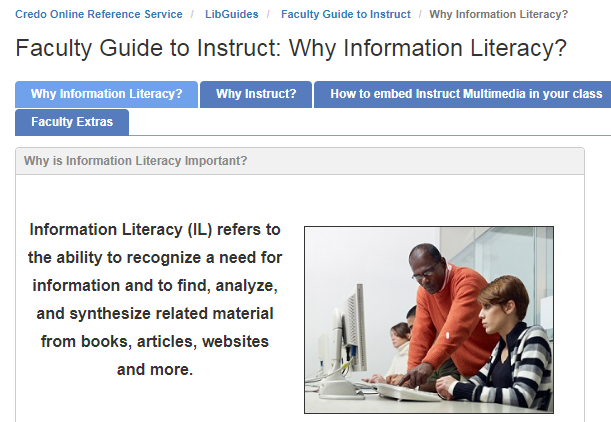The latest issue of College and Research Libraries includes an examination of how 15 librarians use the ACRL Framework for Information Literacy for Higher Education in their work. “Implementing the ACRL Framework: Reflections from the Field,” by Don Latham, Melissa Gross, and Heidi Julien, reports some good news: the framework is being used by the librarians surveyed, though more it is implicit in their work than explicitly spelled out. Less positive is that some reported librarian and faculty opinions that the document is “too highly conceptual to be practical for students.”
Information Literacy, InfoLit Learning Community, ACRL Framework, Community Colleges
Join the Conversation on Research Misperceptions
As you no doubt tell students, research is a conversation, and this week the conversation involves student misperceptions of the research process.
This is a topic recently explored in a 2018 paper by Lisa Janicke Hinchliffe, Allison Rand, and Jillian Collier, all librarians at the University of Illinois at Urbana-Champaign. Their work, “Predictable Information Literacy Misperceptions of First-Year College Students,” in turn continued a conversation, as it leaned on Understanding by Design by Grant Wiggins and Jay McTighe (2005), a seminal book on instructional design that discusses how, in all fields, “any domain of learning, instructors will have developed a sense of the typical errors learners make.” In their paper, Hinchliffe, Rand, and Collier describe a study they performed (the research-gathering step of the study was sponsored by Credo and Hinchliffe presented a related Credo webinar) in which they interviewed librarians about first-year students’ misunderstandings about the research process. Freshman students, they found,
Instruction Focus: Research Skills in the Health Sciences
As we wrote earlier in this interview with Anna Yang, librarians play a critical role in teaching information literacy and other foundational skills to students in the health sciences. It’s no secret that, across all disciplines, library instruction can have a positive impact on everything from retention to GPA-levels to graduation rates. Clinical professions’ reliance on strong research skills, however, creates a unique need for library support in this quickly growing field.
Information Literacy, Library Instruction, InfoLit – Health Science
The ACRL Frame "Information has Value": On Screens Near You!
If you are using the ACRL Framework for Information Literacy for Higher Education in your work, you’re challenged with teachings students the ins and outs of how the articles, books, and websites they use in their research come to be. Particularly when considering the frame “Information has value,” students must learn about the business of scholarship—who produces it, what they produce, who controls what makes it to library shelves, and where the money goes.
Webinars on Accreditation Tips, Faculty Outreach, and More
Ready for some brief and free professional development? Try the webinars that are archived in Credo’s InfoLIt Learning Community. Each one is an hour long and presents an expert or group of experts on some aspect of information literacy. Some of the offerings focus on best practices and tips regarding Credo’s learning tools, but many others highlight pedagogical practices, successful IL programs, and ways of reaching students and faculty with your IL work. The webinars are available at the Webinars and Events section of the community, with some recent programs including:
Supporting Information Literacy in African American Studies
By A.J. Muhammad and Raymond Pun
Today there are opportunities to integrate information literacy into interdisciplinary fields such as Ethnic Studies including African American Studies. According to the Encyclopedia of the World of Sociology, “African American Studies is an academic discipline that focuses on the cultural, political, economic, religious, and social development of black Americans. First established in American universities in the late 1960s, African American Studies Departments were, in part, the product of student protests and the social climate created by the Civil Rights movement and the Black Power movement.” In this interview, Librarian A.J. Muhammad shares his experiences incorporating research and information literacy skills into his work at The New York Public Library’s Schomburg Center For Research Black Culture.
Serving Different Age Groups? Try Some Crossover IL Content
Particularly if you’re in a public library, the material you use to teach information literacy to patrons has to work for those with different IL levels and needs. The following are examples of materials you can use to check different age-level boxes. Remember too that other items you find can often be tweaked to suit your patron population; part of the skill involved in IL work is adapting the resources you find to match local needs.
Credo has developed a new LibGuide that can help introduce our Instruct product to your faculty. The guide discusses why information literacy is important and how Instruct can help improve student performance without taking away valuable class time. Please feel free to copy our LibGuide and customize it—the spots where you should add links to your institution’s subscription are highlighted in red.
By Jennifer Shimada and Raymond Pun
There has been a long practice in teaching information literacy in various areas of education studies such as P-12 focus, counseling, special education, curriculum studies, educational leadership and policy, and so forth. In addition, many graduate programs in education are offered remotely, where students and faculty are part of a distance learning community. How can librarians support graduate studies in education and distance services? In this interview, Librarian Jennifer Shimada shares some tips and resources from her role supporting online learning programs and instructional services at Relay Graduate School of Education.
Information literacy librarians (correctly) teach students to evaluate the websites they use for papers and other academic purposes by looking at features such as the site’s domain, its appearance, who the author is, etc. These are necessary steps, but there are increasing calls for evaluation to be broader. Mike Caulfield’s Web Literacy for Student Fact Checkers, for example, encourages “lateral reading,” an approach that involves reading “about” a website or other source in addition to reading and analyzing the source itself. Lateral reading of a website involves a short scan of the site followed by researching its ownership and what other sources say the site to help decide whether the information there can be trusted or not.



/Images/doctor_computer.jpg)

/Images/AfricanAmericanStudies.jpg)


/Images/ILeducation.jpg)
